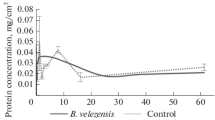Summary
The immobilization intensity of cells of Penicillium frequentans and Candida parapsilosis on materials such as granular clay, granular clay + aquifer sand and aquifer sand alone, was followed by scanning electron microscopy (SEM). The results demonstrate that the granular clay was the best adsorbent for both organisms, followed by the mixture of both granular clay and aquifer sand. Poor adhesion of cells was detected on using aquifer sand alone with C. parapsilosis.
The highest degree of degradation of the alkane mixture (C12−C18) used was achieved by cells immobilized on granular clay, followed by those cells adsorbed on clay and sand. The weakest degradation was observed with cells immobilized on the sand alone.
Similar content being viewed by others
References
Battermann G, Werner P (1984) Beseitigung einer Untergrundkontamination mit Kohlenwasserstoffen durch mikrobiellen Abbau. GWF-Wasser/Abwasser 125:366–373
Bertrand JC, Rambeloarisoa E, Rontani JF (1983) Microbial degradation of crude oil in sea water in continuous culture. Biotechnol Lett 5:567–572
Bossert I, Kachel W, Bartha R (1984) Fate of hydrocarbon during oily sludge disposal in soil. Appl Environ Microbiol 47:763–767
Ehrhardt HM, Rehm HJ (1985) Phenol Degradation by Microorganisms Adsorbed on Activated Carbon. Appl Microbiol Biotechnol 21:32–36
Eikmeier H, Westmeier F, Rehm HJ (1984) Morphological development of Aspergillus niger immobilized in Ca-alginate and K-carrageenan. Appl Microbiol Biotechnol 19:53–57
El-Aassar SAH (1985) Hydrocarbon oxidation by immobilized microorganisms. PH. D. Thesis, Alexandria University, Faculty of Science and Institut für Mikrobiologie, Westf. Wilhelms-Universität, Münster, FRG.
Kincannon CB (1972) Oily waste disposal by soil cultivation process. US Environ Protection Agency Report EPA-R272-110 Washington DC, 115 pp
Kopp B, Rehm HJ (1984) Semicontinuous cultivation of immobilized Claviceps purpurea. Appl Microbiol Biotechnol 19:141–145
Kuek C, Armitage TM (1985) Scanning electron microscopic examination of calcium alginate beads immobilizing growing mycelia of Aspergillus phoenicus. Enzyme Microb Technol 7:121–125
Mahmoud W, Rehm HJ (1986) Morphological examination of immobilized Streptomyces aureofaciens during chlorotetracycline fermentation. Appl Microbiol Biotechnol 23:305–310
Mattiasson B (ed) (1983) Immobilized cells and Organelles Vol I, II CRC Press Inc Boca Raton Florida
Messing RA (1982) Immobilized microbes and high-rate, continuous waste processor for the production of high Btu gas and the reduction of pollulants. Biotechnol Bioeng 24:1115–1123
Messing RA, Oppermann RA (1979) Pore dimensions for accumulating biomass. I Microbes that reproduce by fission or by budding. Biotechnol Bioeng 21:49–58
Messing RA, Oppermann RA, Kolot FB (1979) Pore dimensions for accumulating biomass. II Microbes that form spores and exhibit mycelial growth. Biotechnol Bioeng 21:59–67
Pirbazari M, Voice ThC, Hollingworth PJ, Pirbazari M, Weber WJ Jr (1979) Scanning electron microscopy of biological growth on granular adsorbens used in water and waste-water treatment processes. 37th Annual Meeting of the Electron Microscopy Society of America, 13–17 August (1979) San Antonio Texas
Raymond RL, Hudson JO, Jamison VW (1976) Oil degradation in soil. Appl Environ Microbiol 31:522–535
Rosenbauer KA, Kegel BH (1978) Rasterelektronen mikroskopische Technik. Stuttgart G Thieme
Sandvik S, Lode A, Pedersen TA (1986) Biodegradation of oily sludge in Norwegian soils. Appl Microbiol Biotechnol 23:297–301
Tuschewitzki GJ, Werner P, Dott W (1983) Biologische Besiedlung und mineralische Ablagerungen auf Filtermaterialien zur Trinkwasseraufbereitung. GWF-Wasser/Abwasser 124:521–526
Weber WJ Jr, Pirbazari M, Nelson GL (1978) Biological growth on activated carbon: An investigation by scanning electron microscopy. Environ Sc Techn 12:817–819
Author information
Authors and Affiliations
Rights and permissions
About this article
Cite this article
Omar, S.H., Rehm, H.J. Degradation of n-alkanes by Candida parapsilosis and Penicillium frequentans immobilized on granular clay and aquifer sand. Appl Microbiol Biotechnol 28, 103–108 (1988). https://doi.org/10.1007/BF00250507
Received:
Accepted:
Issue Date:
DOI: https://doi.org/10.1007/BF00250507




